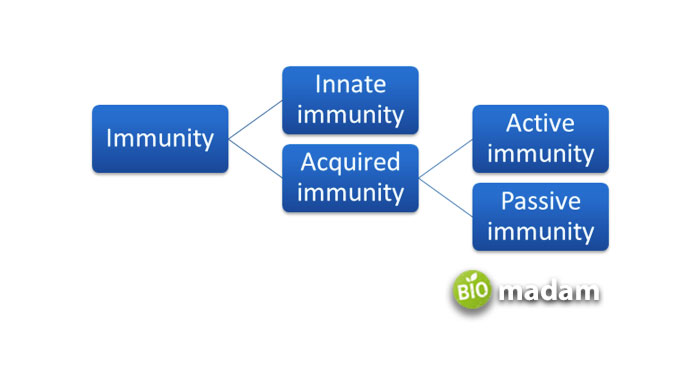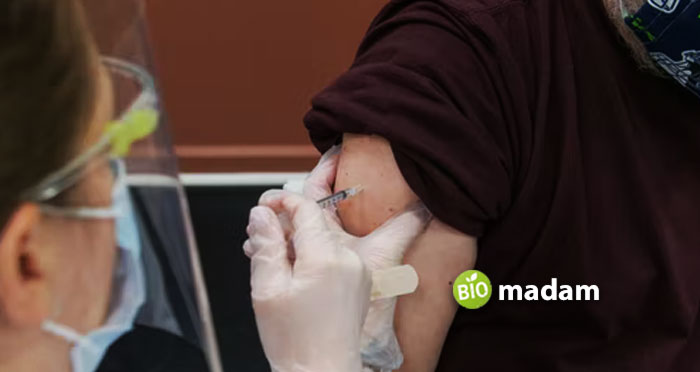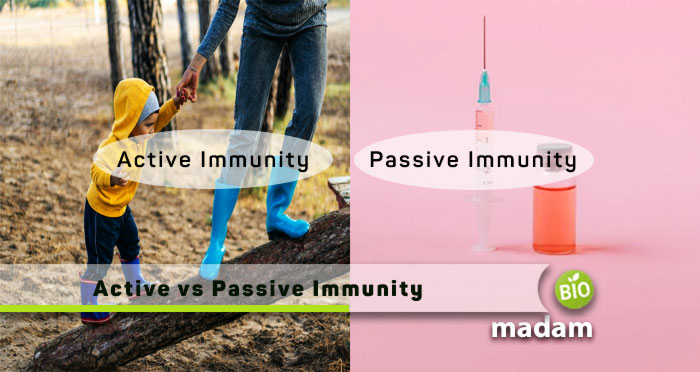Recently updated on February 13th, 2023 at 11:10 am
Do you wonder how we don’t always feel sick despite the various microorganisms in our surroundings?
Your immune system keeps you safe from disease-causing viruses and bacteria by killing them before they harm you. It comprises cells, tissues, and organs that kill pathogens. The immune system is generally categorized into innate and acquired immunity. While innate immunity is naturally obtained, active and passive immunity belongs to the acquired immunity that we develop over time.
Let’s show you how they are classified and tell you all about immunity, including the differences between active and passive immunity for better understanding.
Comparison Table
| Factors | Active Immunity | Passive Immunity |
| Natural Acquirement | After interaction with a pathogen | Through the placenta/breastmilk |
| Immunity Type | Humoral & cell-mediated | Antibodies |
| Involved Cells | B cells, T cells, APCs | No cells involved |
| Immunological Memory | Yes | No |
| Secondary Response | Yes | No |
| Usage | Prophylaxis | Post-exposure treatment |
| Effectiveness | Effective protection | May not offer complete protection |
| Lag Period | Yes | No |
| Hypersensitivity Reactions | No | May be |
| Immunocompromised Persons | Unsuitable | Suitable choice |
What is Immunity?
Before we talk about the dissimilarities between passive and active immunity, it is important to understand how immunity works. Immunity means the resistance of a host to a parasite or other foreign entities that may harm our body. The tissues and cells which are a part of the immune system produce an immune response whenever an external factor enters your body. The immune system saves you against environmental and internal disease-causing factors.
Types of Immunity

Active and Passive Immunity Origin
Active and passive immunity are two types of acquired immunity. Acquired immunity is the type of immune response we acquire throughout our lifetime. It could be due to different channels like exposure to antigens, pathogens, diseases, infections, vaccination, or immunity from another person’s antibodies. Active and passive are obtained from different sources and act in different ways to prevent our bodies.
Active Immunity
Active immunity is the most common type of immunity that your body acquires through external means. Immune B and T cells attack microorganisms, e.g., bacteria, yeast, viruses, etc., that pass the body’s first line of action. Active immunity develops when a foreign body or a pathogen enters your body.
Once the immunity cells are activated to fight a particular pathogen, they remember it and respond the same way the next time.

Passive Immunity
Passive immunity refers to the immunity developed by your body through another source. Two common examples of passive immunity include breastmilk and vaccines.
- When the mother breastfeeds the baby after being born, the milk contains antibodies to help the baby fight against diseases besides innate immunity.
- Another common example of passively acquired immunity is vaccination, for e.g., the influenza vaccine. When an organism is inoculated into your body, the body cells attack to kill it. The immune cells kill and memorize the pathogen to perform the same way if needed in the future.
While the pattern of acquiring active and passive immunity is dissimilar, a few other factors also distinguish active immunity from passive immunity. Here’s a list of the differences between active and passive immunity.

Difference between Active and Passive Immunity
Definition
Active Immunity
If immunity is acquired by the body itself to act on an external pathogen, it is called active immunity.
Passive Immunity
Alternatively, if an individual acquires immunity through antibodies from another human being, it is called passive immunity.
Natural Acquirement
Active Immunity
Active immunity is naturally acquired when the cells activate to fight against an invader.
Passive Immunity
On the other hand, passive immunity is naturally acquired through the mother’s placenta or breast milk.
Type of Immunity
Active Immunity
It involves cell-mediated and humoral immunity.
Passive Immunity
Whereas it does not require activated immunity as the antibodies perform against pathogens.
Involved Cells
Active Immunity
Active immunity involves B cells, T cells, and antigen-presenting cells. They include helper T cells, cytotoxic T cells, memory T cells, memory B cells, plasma cells, macrophages, and dendritic cells.
Passive Immunity
Unlike active immunity, passive immunity does not involve any of the immunity cells.
Immunological Memory
Active Immunity
When the body cells respond actively to an entity, they remember the pathogen and produce the same response in the future.
Passive Immunity
Conversely, passive immunity, such as through breast milk, does not produce immunological memory.
Secondary Response
Active Immunity
In active immunity, the body activates antibodies in response to foreign antigens. After the first activation, the body remembers it for a lifetime and fights the same way.
Passive Immunity
In contrast, passive immunity stays for a short time as memory is not formed.
Usage
Active Immunity
As the cells remember the previous response, they are effective for prophylaxis.
Passive Immunity
However, passive immunity acquired through other sources is more suited as a post-exposure solution.
Protection
Active Immunity
Active immunity provides adequate protection against foreign bodies once acquired.
Passive Immunity
In comparison, protection through passive immunity may not sometimes offer complete immunity and is not as effective as active immunity.
Lag Period
Active Immunity
Active immunity has a lag period to recall the previous interaction with the harmful antigens.
Passive Immunity
Yet, passive immunity acts immediately without any lag period.
Hypersensitivity Reactions
Active Immunity
Active immunity developed by the body itself does not cause any reactions.
Passive Immunity
On the other hand, the introduction of passive immunity may cause a reaction or have side effects.
Immuno-Compromised Persons
Active Immunity
Active immunity is not the right choice for protecting immune-compromised people against pathogens.
Passive Immunity
Though passive immunity is more suited to people with compromised or deficient immune systems.
What are Immunocompromised Persons?
Immunocompromised persons are those whose immune system has a reduced capability of fighting antigens and pathogens. There could be several reasons for being immunocompromised, including the intake of immunosuppressants that suppress your immune system. A person may be temporarily or permanently immunocompromised.
The Bottom Line
Immunity plays a critical role in ensuring the health and saving you from diseases. While innate immunity is inbuilt, acquired immunity develops during the lifetime through different means. The acquired immunity might be active or passive, depending on how the immunity is developed. The body produces active immunity in response to a foreign body, while passive immunity is received through another person’s antibodies. Active immunity creates immunological memory. Subsequently, passive immunity is more suitable for immunocompromised people.

Anna has completed her degree in Pharmacy from the University of Hawaii. She is serving as a research assistant in a pharmaceutical company. She had a great interest in writing blogs, traveling to different parts of the US, and trying delicious recipes in her spare time.

